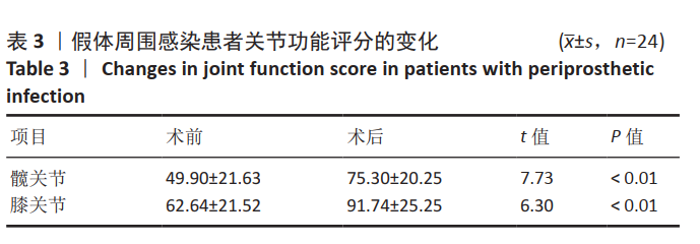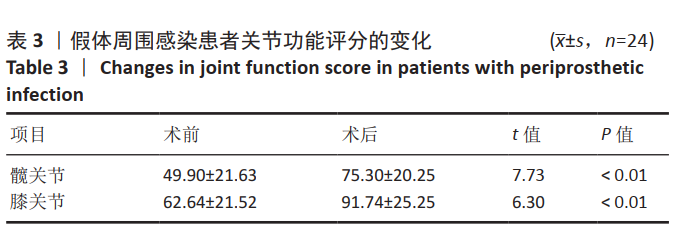[1] MCLAWHORN AS, NAWABI DH, RANAWAT AS. Management of Resistant, Atypical and Culture-negative Periprosthetic Joint Infections after Hip and Knee Arthroplasty. Open Orthop J. 2016;10:615-632.
[2] NGUYEN M, SUKEIK M, ZAHAR A, et al. One-stage Exchange Arthroplasty for Periprosthetic Hip and Knee Joint Infections. Open Orthop J. 2016;10:646-653.
[3] DELLA VALLE CJ, ZUCKERMAN JD, DI CESARE PE. Periprosthetic sepsis. Clin Orthop Relat Res. 2004;(420):26-31.
[4] RISITANO S, SABATINI L, ATZORI F, et al. Static antibiotic spacers augmented by calcium sulphate impregnated beads in revision TKA: Surgical technique and review of literature. J Orthop. 2018;15(2): 313-318.
[5] FERGUSON J, DIEFENBECK M, MCNALLY M. Ceramic Biocomposites as Biodegradable Antibiotic Carriers in the Treatment of Bone Infections. J Bone Jt Infect. 2017;2(1):38-51.
[6] 林志炯,曾焘,高大伟.可吸收载药型硫酸钙治疗关节置换术后早期感染[J].中华关节外科杂志(电子版),2019,13(4):498-502.
[7] OUSSEDIK S, GOULD K, STOCKLEY I, et al. Defining peri-prosthetic infection: do we have a workable gold standard? J Bone Joint Surg Br. 2012;94(11):1455-1456.
[8] TANDE AJ, PATEL R. Prosthetic joint infection. Clin Microbiol Rev. 2014;27(2):302-345.
[9] AKGÜN D, PERKA C, TRAMPUZ A, et al. Outcome of hip and knee periprosthetic joint infections caused by pathogens resistant to biofilm-active antibiotics: results from a prospective cohort study. Arch Orthop Trauma Surg. 2018;138(5):635-642.
[10] MCCONOUGHEY SJ, HOWLIN R, GRANGER JF, et al. Biofilms in periprosthetic orthopedic infections. Future Microbiol. 2014;9(8): 987-1007.
[11] ABOSALA A, ALI M. The Use of Calcium Sulphate beads in Periprosthetic Joint Infection, a systematic review. J Bone Jt Infect. 2020;5(1):43-49.
[12] TSUKAYAMA DT, ESTRADA R, GUSTILO RB. Infection after total hip arthroplasty. A study of the treatment of one hundred and six infections. J Bone Joint Surg Am. 1996;78(4):512-523.
[13] 宋海波,陈洁,刘宏.关节镜下清创治疗人工膝关节置换术后早期 感染的临床分析[J].中国骨伤,2017,30(4):318-321.
[14] 顾继生,蔡晓冰,朱明.载万古霉素MSNs复合硫酸钙制备人工骨的缓释与抗菌作用研究[J].生物骨科材料与临床研究,2019,16(1):8.
[15] 王宏,伍权,汤耿,等.个性化膝关节抗生素骨水泥占位器的设计及临床应用[J].中国组织工程研究,2020,24(6):821-826.
[16] INZANA JA, SCHWARZ EM, KATES SL, et al. Biomaterials approaches to treating implant-associated osteomyelitis. Biomaterials. 2016;81:58-71.
[17] MCNALLY MA, FERGUSON JY, LAU AC, et al. Single-stage treatment of chronic osteomyelitis with a new absorbable, gentamicin-loaded, calcium sulphate/hydroxyapatite biocomposite: a prospective series of 100 cases. Bone Joint J. 2016;98-B(9):1289-1296.
[18] FERGUSON JY, DUDAREVA M, RILEY ND, et al. The use of a biodegradable antibiotic-loaded calcium sulphate carrier containing tobramycin for the treatment of chronic osteomyelitis: a series of 195 cases. Bone Joint J. 2014;96-B(6):829-836.
[19] COOPER JJ, FLORANCE H, MCKINNON JL, et al. Elution profiles of tobramycin and vancomycin from high-purity calcium sulphate beads incubated in a range of simulated body fluids. J Biomater Appl. 2016; 31(3):357-365.
[20] SANICOLA SM, ALBERT SF. The in vitro elution characteristics of vancomycin and tobramycin from calcium sulfate beads. J Foot Ankle Surg. 2005;44(2):121-124.
[21] WAHL P, GUIDI M, BENNINGER E, et al. The levels of vancomycin in the blood and the wound after the local treatment of bone and soft-tissue infection with antibiotic-loaded calcium sulphate as carrier material. Bone Joint J. 2017;99-B(11):1537-1544.
[22] HELGESON MD, POTTER BK, TUCKER CJ, et al. Antibiotic-impregnated calcium sulfate use in combat-related open fractures. Orthopedics. 2009;32(5):323.
[23] JIANG N, LIU GQ, YANG JJ, et al. Is Hypercalcemia a Frequent Complication following Local Use of Calcium Sulfate with Antibiotics for the Treatment of Extremity Posttraumatic Osteomyelitis? A Preliminary Study. Biomed Res Int. 2019;2019:7315486.
|



